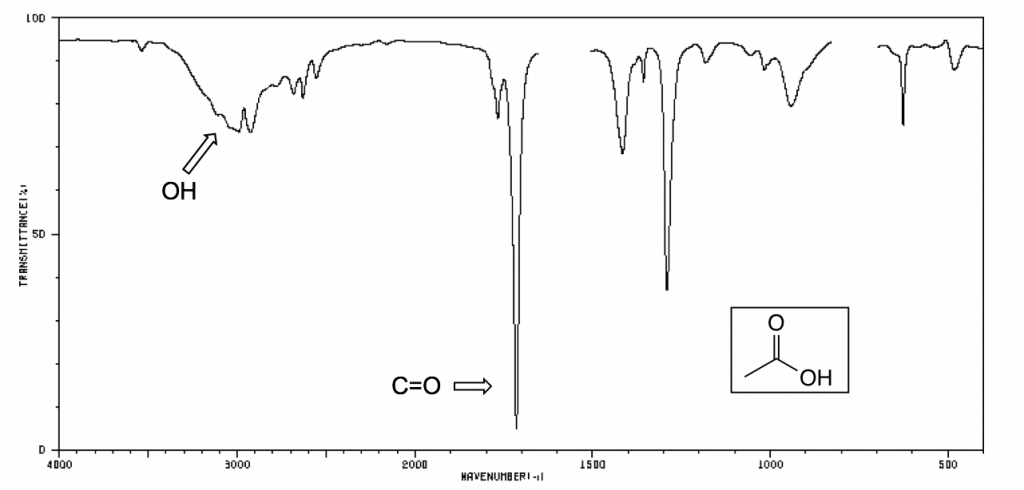6.4: IR Spectrum Interpretation Practice
- Page ID
- 359596
\( \newcommand{\vecs}[1]{\overset { \scriptstyle \rightharpoonup} {\mathbf{#1}} } \)
\( \newcommand{\vecd}[1]{\overset{-\!-\!\rightharpoonup}{\vphantom{a}\smash {#1}}} \)
\( \newcommand{\id}{\mathrm{id}}\) \( \newcommand{\Span}{\mathrm{span}}\)
( \newcommand{\kernel}{\mathrm{null}\,}\) \( \newcommand{\range}{\mathrm{range}\,}\)
\( \newcommand{\RealPart}{\mathrm{Re}}\) \( \newcommand{\ImaginaryPart}{\mathrm{Im}}\)
\( \newcommand{\Argument}{\mathrm{Arg}}\) \( \newcommand{\norm}[1]{\| #1 \|}\)
\( \newcommand{\inner}[2]{\langle #1, #2 \rangle}\)
\( \newcommand{\Span}{\mathrm{span}}\)
\( \newcommand{\id}{\mathrm{id}}\)
\( \newcommand{\Span}{\mathrm{span}}\)
\( \newcommand{\kernel}{\mathrm{null}\,}\)
\( \newcommand{\range}{\mathrm{range}\,}\)
\( \newcommand{\RealPart}{\mathrm{Re}}\)
\( \newcommand{\ImaginaryPart}{\mathrm{Im}}\)
\( \newcommand{\Argument}{\mathrm{Arg}}\)
\( \newcommand{\norm}[1]{\| #1 \|}\)
\( \newcommand{\inner}[2]{\langle #1, #2 \rangle}\)
\( \newcommand{\Span}{\mathrm{span}}\) \( \newcommand{\AA}{\unicode[.8,0]{x212B}}\)
\( \newcommand{\vectorA}[1]{\vec{#1}} % arrow\)
\( \newcommand{\vectorAt}[1]{\vec{\text{#1}}} % arrow\)
\( \newcommand{\vectorB}[1]{\overset { \scriptstyle \rightharpoonup} {\mathbf{#1}} } \)
\( \newcommand{\vectorC}[1]{\textbf{#1}} \)
\( \newcommand{\vectorD}[1]{\overrightarrow{#1}} \)
\( \newcommand{\vectorDt}[1]{\overrightarrow{\text{#1}}} \)
\( \newcommand{\vectE}[1]{\overset{-\!-\!\rightharpoonup}{\vphantom{a}\smash{\mathbf {#1}}}} \)
\( \newcommand{\vecs}[1]{\overset { \scriptstyle \rightharpoonup} {\mathbf{#1}} } \)
\( \newcommand{\vecd}[1]{\overset{-\!-\!\rightharpoonup}{\vphantom{a}\smash {#1}}} \)
Now, let’s take a look at the more IR spectrum for examples. It is very important to keep in mind that generally we do not try to identify all the absorption bands in an IR spectrum. Instead, we will look at the characteristic absorption band to confirm the presence or absence of a functional group. An IR spectrum usually does not provide enough information for us to figure out the complete structure of a molecule, and other instrumental methods have to be applied in conjunction with, such as NMR that we will learn in later sections, that is a more powerful analytical method to give more specific information about molecular structures.

In the IR spectrum of 1-hexanol, there are sp3 C-H stretching bands of alkane at about 2800-3000 cm-1 as expected. Other than that, there is a very broad peak centered at about 3400 cm-1, that is the characteristic band of the O-H stretching mode of alcohols.

The spectrum for 1-octene shows two bands that are characteristic of alkenes: the one at 1642 cm -1 is due to stretching of the carbon-carbon double bond, and the one at 3079 cm -1 is due to stretching of the σ bond between the sp 2 -hybridized alkene carbons and their attached hydrogens.
The following IR spectrum are taken from Spectral Database for Organic Compounds, the free organic compounds spectral database. The key bands for each compound are labelled on the spectra.





